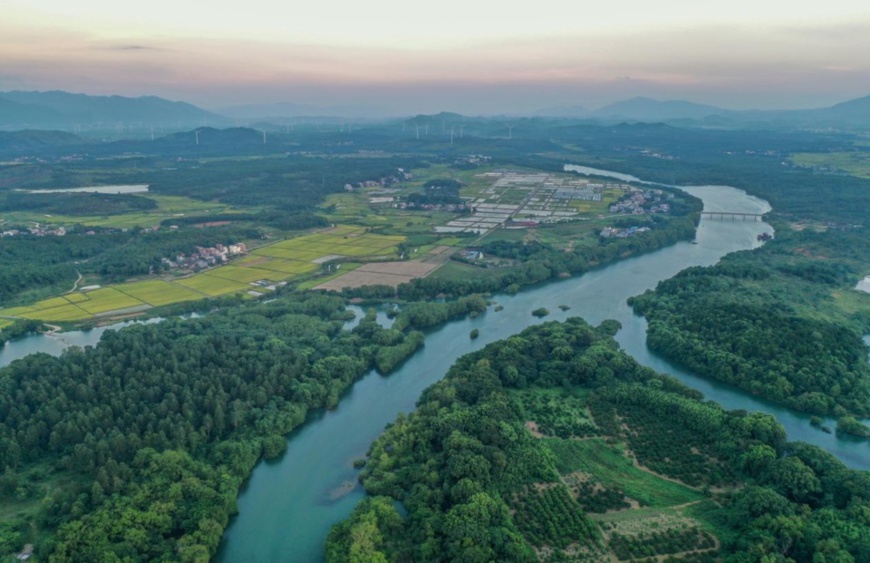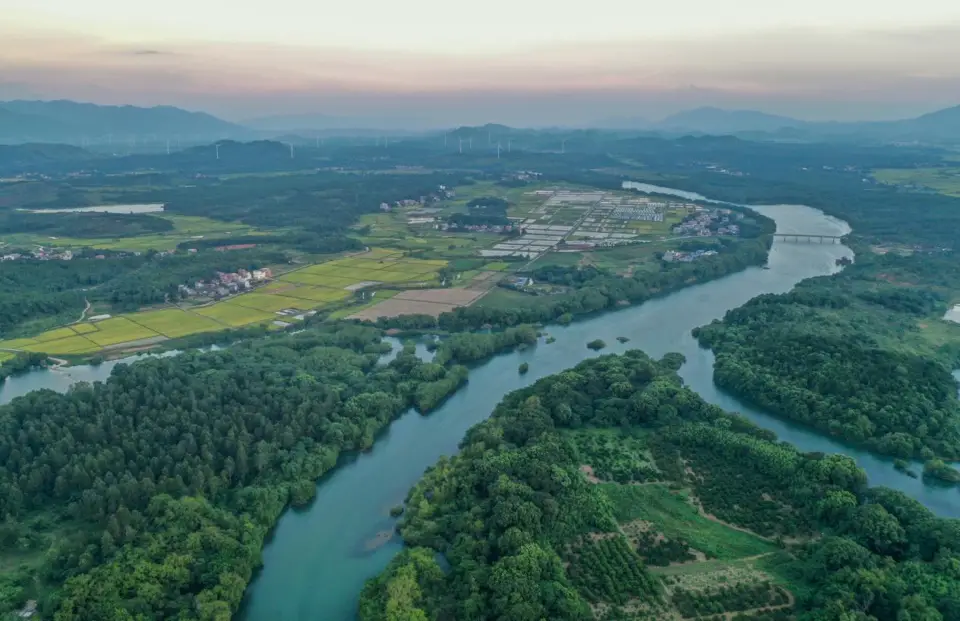By Li Guoying

Photo shows luxuriant forests and lucid water at a wetland in Xianglinpu township, Daoxian county, Yongzhou city, central China’s Hunan province, July 12, 2021. (Photo by Jiang Keqing/People’s Daily Online)
China’s practice in the past five years has fully proven that the implementation of the system of river and lake chiefs across the board is completely in conformity with the country’s national and water conditions, is a fundamental and groundbreaking policy on the protection and governance of rivers and lakes, and represents a major institutional innovation with strong vitality.
Over the past five years, China’s Ministry of Water Resources (MWR), together with various regions and departments in the country, has promoted the solving of many tough problems in the protection and governance of rivers and lakes that were long on the agenda but never resolved, bringing historic changes to rivers and lakes in China.
Since 2018, China has established the system of river and lake chiefs across the country. Under the system, major leaders of the Communist Party of China (CPC) committees and governments of 31 provincial-level regions in the country have been appointed as general chiefs responsible for all rivers and lakes in the region.
By designating a total of 300,000 river and lake chiefs at provincial, municipal, county, and township levels and more than 900,000 village-level river and lake chiefs (including river patrol personnel and river rangers), China has made sure the responsibility for the management and protection of all the rivers and lakes has been assigned.
The State Council of China has initiated an inter-ministerial joint conference on the comprehensive implementation of the system, established and improved mechanisms covering the fulfillment of responsibility by river and lake chiefs, supervision and inspection, evaluation and accountability as well as positive incentives to promote the implementation of the system.
Nationwide efforts have also been made to establish provincial-level joint conference mechanism for river and lake chiefs in the Yangtze River and the Yellow River basins as well as joint prevention and control mechanism for coordination and collaboration between personnel in charge of the upstream section and downstream section and the right and left banks of rivers and lakes, inter-departmental joint response mechanism, the system of river patrol personnel and rangers, the system of folk river chiefs, and joint governance mechanism for all sectors of the society, which leads to the forming of a powerful synergy for the conservation of rivers and lakes.
Local governments across the country have established archives and formulated targeted policies for each river, and clearly defined the boundaries of 1.2 million kilometers of rivers and 1,955 lakes for management and control for the first time.
Besides, local authorities have also carried out a special campaign to regulate illegal riverside occupation, mining, heap and construction and special operations to overhaul projects along the shorelines of the Yangtze River and the Yellow River, addressing 185,000 prominent problems, demolishing more than 40 million square meters of illegal construction projects and over 10,000 kilometers of illegal dikes, removing more than 40 million tons of garbage from watercourses, clearing 30,000 kilometers of illegally occupied shorelines, and seizing over 11,000 ships for illegal sand mining.
Since northern China made comprehensive efforts to stem groundwater overexploitation, groundwater levels in some regions have stopped falling and started to rise, many river courses in north China which had been cut off for years, such as Yongding River, Daqing River, Hutuo River, and Ziya River, have been fully connected, and the Baiyangdian Lake in north China’s Hebei province has regained its beauty.
All cities at or above the prefecture level have basically eliminated all of their “black and odorous” water bodies.
In 2020, the proportion of water sections with excellent or good surface water (Class I to Class III) increased by nearly 16 percentage points from 2016.
By promoting the implementation of the river and lake chief system across the board, China has focused its efforts on addressing the most pressing, immediate water-related problems that concern the people the most and created a pleasant environment featuring unimpeded rivers, lucid waters, green banks, beautiful scenery, and harmony between man and nature, winning widespread recognition from the people for the results of river and lake protection and control.
China’s efforts to safeguard the health and safety of rivers and lakes will provide strong support for achieving comprehensive green transition in economic and social development and high-quality development.
(Li Guoying is the minister of water resources.)
Over the past five years, China’s Ministry of Water Resources (MWR), together with various regions and departments in the country, has promoted the solving of many tough problems in the protection and governance of rivers and lakes that were long on the agenda but never resolved, bringing historic changes to rivers and lakes in China.
Since 2018, China has established the system of river and lake chiefs across the country. Under the system, major leaders of the Communist Party of China (CPC) committees and governments of 31 provincial-level regions in the country have been appointed as general chiefs responsible for all rivers and lakes in the region.
By designating a total of 300,000 river and lake chiefs at provincial, municipal, county, and township levels and more than 900,000 village-level river and lake chiefs (including river patrol personnel and river rangers), China has made sure the responsibility for the management and protection of all the rivers and lakes has been assigned.
The State Council of China has initiated an inter-ministerial joint conference on the comprehensive implementation of the system, established and improved mechanisms covering the fulfillment of responsibility by river and lake chiefs, supervision and inspection, evaluation and accountability as well as positive incentives to promote the implementation of the system.
Nationwide efforts have also been made to establish provincial-level joint conference mechanism for river and lake chiefs in the Yangtze River and the Yellow River basins as well as joint prevention and control mechanism for coordination and collaboration between personnel in charge of the upstream section and downstream section and the right and left banks of rivers and lakes, inter-departmental joint response mechanism, the system of river patrol personnel and rangers, the system of folk river chiefs, and joint governance mechanism for all sectors of the society, which leads to the forming of a powerful synergy for the conservation of rivers and lakes.
Local governments across the country have established archives and formulated targeted policies for each river, and clearly defined the boundaries of 1.2 million kilometers of rivers and 1,955 lakes for management and control for the first time.
Besides, local authorities have also carried out a special campaign to regulate illegal riverside occupation, mining, heap and construction and special operations to overhaul projects along the shorelines of the Yangtze River and the Yellow River, addressing 185,000 prominent problems, demolishing more than 40 million square meters of illegal construction projects and over 10,000 kilometers of illegal dikes, removing more than 40 million tons of garbage from watercourses, clearing 30,000 kilometers of illegally occupied shorelines, and seizing over 11,000 ships for illegal sand mining.
Since northern China made comprehensive efforts to stem groundwater overexploitation, groundwater levels in some regions have stopped falling and started to rise, many river courses in north China which had been cut off for years, such as Yongding River, Daqing River, Hutuo River, and Ziya River, have been fully connected, and the Baiyangdian Lake in north China’s Hebei province has regained its beauty.
All cities at or above the prefecture level have basically eliminated all of their “black and odorous” water bodies.
In 2020, the proportion of water sections with excellent or good surface water (Class I to Class III) increased by nearly 16 percentage points from 2016.
By promoting the implementation of the river and lake chief system across the board, China has focused its efforts on addressing the most pressing, immediate water-related problems that concern the people the most and created a pleasant environment featuring unimpeded rivers, lucid waters, green banks, beautiful scenery, and harmony between man and nature, winning widespread recognition from the people for the results of river and lake protection and control.
China’s efforts to safeguard the health and safety of rivers and lakes will provide strong support for achieving comprehensive green transition in economic and social development and high-quality development.
(Li Guoying is the minister of water resources.)
 Menu
Menu
 China’s designation of river, lake chiefs yields notable results
China’s designation of river, lake chiefs yields notable results
















